
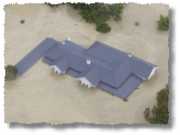 Floods
Floods
In the United States, floods effect more people than any other natural disaster. Floods can be caused by tsunamis, hurricanes, or just plain rainstorms and they are the most frequent natural disaster. Not only that, floods are becoming more and more common in communities as asphalt spreads over the absorbent ground causing fast run-off to overload storm drain systems and overflow stream beds.
Many people are killed by floods. About 80% of those deaths occur in vehicles, usually when people try to drive through flooded areas. It takes only a few inches of rushing water to knock a person down and just 24 inch deep water can push any vehicle off the road and down the river. Don't risk driving through floodwaters, you probably won't make it.
Tsunami Disasters also cause massive flooding, but there are different dangers and preparation steps for tsunamis.

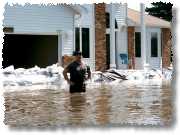 Before a Flood
Before a Flood
If you live along a coast, downstream from a dam, or in a known flood zone, your risk of flood is highest. The safest thing to do when a flood is coming is to evacuate to higher ground.
Keep these flood safety tips in mind:
- Have adequate flood insurance - the most important thing to do.
- Create your family emergency plan and train your family.
- Make sure all family members know the best routes for evacuation.
- Ensure your sump pump is operational and discharging water well away from the house.
- Keep your 72 hour emergency kit ready and grab it on your way out the door.
- Monitor weather reports, especially during the rainy season in your area.
- Fill your car with gas as soon as you hear of a possible flood.
- Move precious family property and keepsakes to upper floors or the attic.
- Depending on the forecast flood level, you may attempt to barricade your home with sandbags to keep the water out. Read sandbagging information from NDSU.
- Wrap fridge, clothes washer, dryer type appliances with a sheet and then stretchable plastic wrap and tape in place. This won't keep out water, but will help filter out much of the silt for easier clean-up.
- Move patio furniture and other things that may float away into the garage.
- Fill spare water containers in case water source becomes contaminated.
- Move emergency food supply to higher floors.
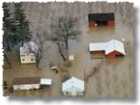 During a Flood
During a Flood
- Evacuate to higher ground if advised by authorities or radio or sirens. Evacuation is the best way to ensure the safety of your family members.
- If you believe water will reach your home, turn off the main electricity, water, and gas valves before evacuating.
- Stay clear of flooded areas until the water has completely gone.
- Do not walk or drive through moving water.
- Keep an eye out for snakes and other stressed animals coming out of flooded areas.
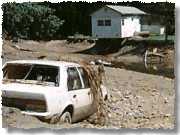 After a Flood
After a Flood
- Check your home for structural damage before entering.
- Check for gas leaks and other fire hazards.
- Turn off electricity and keep it off until the house has dried out.
- Contact your insurance representative to make a claim and start the clean-up process.
- Discard all food that came in contact with the polluted flood water.
- If electricity was interrupted, discard refrigerated and frozen food unless you know it remained safely cooled.
- Do not use your water source until you are sure it is pure. Test it.
- If you have a septic system, it may be saturated and you will have backed up drains. You will just need to drastically reduce your water use while waiting for the drain field to dry out.
- All appliances, heating system, and electricity system that have been flooded need to be cleaned and dried before use. You should have a professional check out these items.
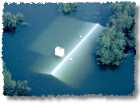 100 Year Flood
100 Year Flood
It is a good idea to make sure your house and other buildings are well above something called the 100 year flood line. Flood insurance uses the 100 year flood line in determining the insurance rate. On plat drawings of your property, you may see a 100 year flood line. This magical line is not the highest point water has reached in the past 100 years. It also isn't the height that water should reach every 100 years.
The 100 year flood level means that there is a 1 in 100 chance of water reaching that height in any year. Over hundreds and hundreds of years, that would average out to once every 100 years. But, in a very rainy year there may be 2 or more floods reaching that height a month or even a week apart. Not only that, but if conditions are just right, a single flood may reach the 500 year flood line or 1000 year flood line. These would be very rare, very disastrous floods but they will occur at some point in time.
One other thing to keep in mind - the 100 year flood line tends to get higher and higher as more and more development occurs causing more run-off and less natural water absorption. So, the line on a decade old plat drawing may be lower than it should be.

Find Emergency and Disaster Info at www.EmergencyDude.com

